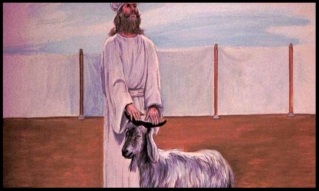In Geneses 3 we began talking about Atonement. The covering of sin only God makes through a substitute, a sacrifice. God appointed a yearly sacrifice to cleanse all the sins and impurities, not covered by the other sacrifices, that the Israelites committed ignorantly. Stop where you are and read Hebrews 9. Click here of you are not near a Bible.
The Day of Atonement took place six months after the Passover. These two festivals were a half a year apart. As for as modern day application for Jewish people, it is called Yom Kippur. For Christians, it is one of the 3 Feasts not fulfilled yet. (Look back at your handouts)
Moses received instructions regarding the Day of Atonement, immediately after the judgment of Nadab and Abihu. The high priest had to make elaborate preparations for entering the Holy of Holies, by cleansing himself both spiritually and physically. The offerings he made were a bull as a “sin offering” and a ram as a “burnt offering,” both to cover his own sins. He also had to wear a special uniform, not the ornate garments that he usually wore to carry out his regular duties.

Then he “cast lots” (like rolling die, so the Lord made the decision, not the priest) to decide which of the “two goats” would die as a sin offering for the people, and which one would be sent as “the scapegoat” (the guilt of the sin) into the wilderness. The sacrificed goat perished and the scapegoat took away the impurities and sins to the wilderness. The sacrificed goat is a picture of Jesus, the scapegoat frees us from the guilt of our sins.

(Now the only problem was that this goat sometimes wandered back into the Israelites’ camp, which nobody wanted to see because it was like having their sins come back on them. Supposedly, the person who led the goat into the wilderness often took the goat to a cliff and pushed it off. That’s a picture of complete redemption—the guilt never showed up again.) Lots of self reflection here for application.
Leviticus 17—26 is called the Holiness Code. “Be Holy because I am Holy”
This section begins with people sacrificing to “goat idols,” which is similar to the golden calf incident in Exod. 32. The high priest was responsible for the golden calf apostasy, but the Israelites were personally responsible for the goat idol worship here.
The “goat idol” was a “god” that the Egyptians and other ancient Near Easterners worshiped. It was supposedly responsible for the fertility of the people, their herds, and their crops. I am not going to go into details but people wonder why it specifically states not to have sex with animals…these were pagan rituals they brought with them from Egypt and existed in Canaan where they are headed. These poor goats!
“Blood” is life.
Since God forbade “eating blood” way before the the Law given to Moses (Genesis 9:4), people today should also refrain from eating it (I am not talking about Outback Steakhouse). In Moses day, the pagans superstitiously linked blood consumption with acquiring divine powers (who saw the “eating of the heart” episode on G.O.T.?) Same concept.
“The faithful worshiper of the living God must preserve the
sanctity of sacrificial blood, recognizing that life (signified by
blood) belongs to God.”
CHAPTER 18. Chapter 18 has bookends.
1-5 The Lord said to Moses, 2 “Speak to the Israelites and say to them: ‘I am the Lord your God. 3 You must not do as they do in Egypt, where you used to live, and you must not do as they do in the land of Canaan, where I am bringing you. Do not follow their practices. 4 You must obey my laws and be careful to follow my decrees. I am the Lord your God. 5 Keep my decrees and laws, for the person who obeys them will live by them. I am the Lord.
30: Keep my requirements and do not follow any of the detestable customs that were practiced before you came and do not defile yourselves with them. I am the Lord your God.’”
The Israelites moved from one idolatrous county and are heading to the next. The culture of these nations were worldly desires as well as idol worshiping.
I don’t think you will need help understanding most of these commands but I want to point out one. 18:21 the Molek or Molech (depending on your version). Moloch was a statue with the head of a bull and arms out-stretched as a representation of him receiving the children being sacrificed. “Molech, was a Canaanite god (actually translated ‘king’, often represented by a bronze image with a bull’s head and outstretched arms. The idol was usually hollow, and workers would build a fire in it. The Canaanites then would pass a young child or infant through the fire or place them in it, as sacrifices for worship.

As we get deeper into the Bible, you can put Baal, Ashtoreth and Molech all in the same category. I am often amazed that even as pagans we are are built with an innate natural instinct to know deep inside us that “someone” must be sacrificed…sad they missed this one for a Jesus.